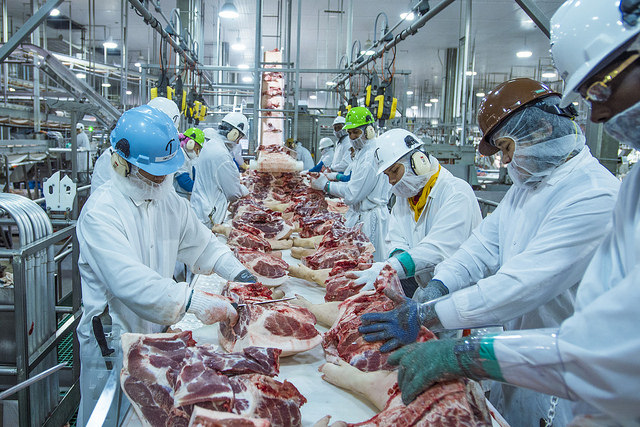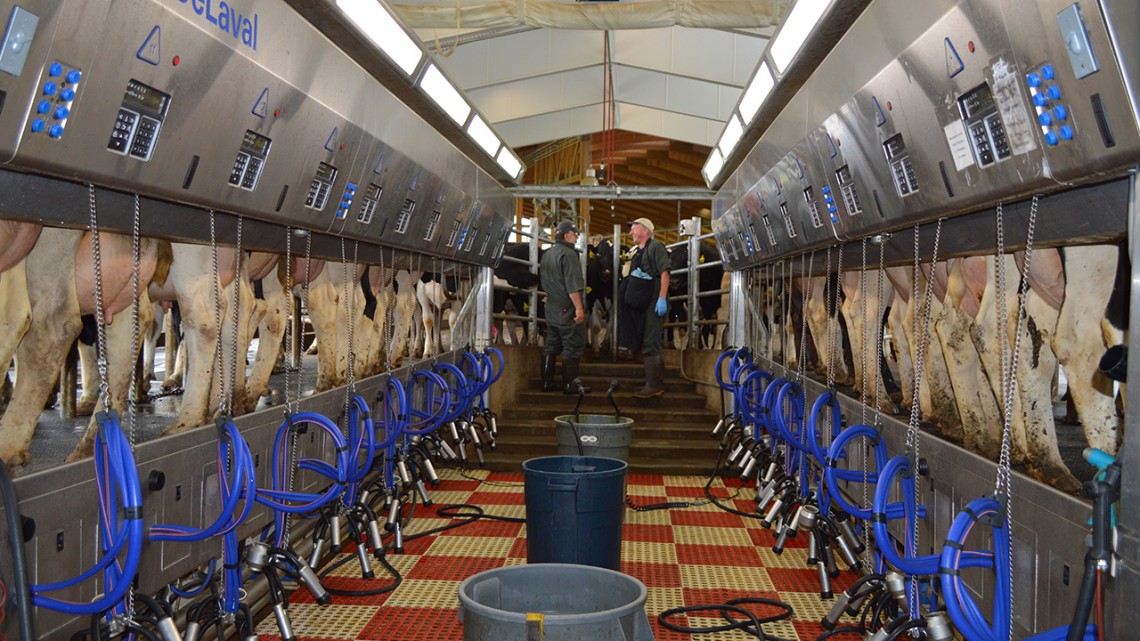



Weekly beef and dairy digest: Australia's dairy industry contends with flood aftermath
US beef sales slip and the dairy industry prepares for peak levels of milk.US beef sales slip from previous week
US Beef net sales of 18,200 metric tonnes (MT) reported for 2021 were down 3% from the previous week and 14% from the prior four-week average.
Increases primarily for South Korea (9,100 MT, including decreases of 700 MT), Japan (4,200 MT, including decreases of 400 MT), China (1,900 MT, including decreases of 100 MT), Mexico (1,300 MT, including decreases of 100 MT), and Taiwan (700 MT, including decreases of 100 MT), were offset by reductions primarily for the Philippines (300 MT) and Vietnam (100 MT).
Exports of 18,800 MT were up 1% from the previous week and 4% from the prior four-week average. The destinations were primarily to South Korea (6,500 MT), Japan (4,700 MT), China (3,200 MT), Mexico (1,100 MT), and Taiwan (1,000 MT).

US agriculture exports to Spain remain strong
USDA has reported that in 2020, the United States exported $1.6 billion worth of agricultural, seafood and forest products to Spain. Preliminary national statistics show that in 2020, the Spanish economy suffered one of the largest slowdowns in the European Union, contracting 11%.
The COVID-19 pandemic and ongoing restriction measures triggered the economic contraction. Tourism and the Hotel, Restaurant, and Institutional sectors, key pillars of the Spanish economy, remain highly impacted by the COVID-19 crisis. While much hope is placed in vaccination and the summer season, a high level of uncertainty remains.
The food-processing sector is considered an essential activity and has continued uninterrupted despite some initial difficulties. Having one of the most competitive food processing industries in Europe, Spain’s demand for ingredients continues to increase, such as tree nuts, distilled spirits, pulses, and food preparations. The post-pandemic environment may also offer new opportunities for ingredients.
Weekly reports from the USDA
Weekly milk report
US fluid milk
Springtime is here and market participants throughout the nation are noting peak levels of milk are fast approaching, particularly in the Western region. Class I sales are somewhat stabilizing with many school districts wrapping up spring breaks.
Cheesemakers are paying from $5 to $4 under Class III for spot milk in the Midwest, although spot milk trading was quieter this week. Cream is slowly tightening in the Midwest and Eastern region, although somewhat plentiful in the West.

Butter producers are bidding a bit higher and receiving fewer cream offers as ice cream plants are revving up production rates. Condensed skim demand has begun to improve, as well.
Some industry contacts relay condensed skim volumes are in balance and meeting current needs. FOB cream multiples are 1.28-1.40 in the East, 1.23-1.34 in the Midwest, and 1.05- 1.28 in the West.
Dry products
Low/medium heat non-fat dry milk (NDM) prices are mixed. Domestic and international demands are reportedly stable. The low/medium heat NDM market tone has somewhat settled. High heat NDM prices are mixed. Some buyers are purchasing on a wider price range. Market conditions are unsettled.
Dry buttermilk prices are fairly steady. Some market participants are purchasing dry buttermilk for their immediate needs. The market tone is sturdy for dry buttermilk.
The price range slightly narrowed in the dry whole milk market this week. The dry whole milk market tone is balanced for the near term. Dry whey prices are steady to higher. Both domestic and international demands are strong.
The dry whey market tone is firm. Whey protein concentrate 34% prices are steady to higher. The demand for higher protein blends is solid. Lactose prices are mostly steady. Trading activities are fairly moderate. The lactose market holds a stable tone. Prices for acid and rennet casein are steady to a bit lower. Casein markets are generally steady.

Weekly dairy retail report
The total number of conventional dairy ads increased this week by 7% to 84,620; total organic ads fell by 1% to 3,387. The most advertised dairy product was conventional 48-64-ounce ice cream, with an average price of $3.17 up 36 cents over last week. The most advertised organic product this week was gallon-sized milk. The average price was $5.11.
Retail advertisements for cheese were led by conventional 8-ounce shred bags, which were advertised 3% more than in the last week. The average price for 8-ounce shred bags of conventional cheese was $2.30 down $0.12 from last week. Organic cheese made a return to the retail survey with 8-ounce shred bags; the average price was $2.99. The organic premium for 8-ounce shred cheese this week was $0.69.
Conventional Greek yogurt in 4-6-ounce containers was the most advertised yogurt product, this period, appearing in 7,190 ads. The weighted average price for this product was $0.97, dropping $0.01 from the week prior. The total number of conventional yogurt ads dropped by 13% compared to the previous survey, while the ad numbers for organic yogurt nearly doubled, growing 99%.
Milk advertisements were highest in gallon sizes for both conventional and organic. Conventional milk gallons advertisements grew by 57% this week, while organic advertisements appeared after taking the previous week off. The price for the conventional gallons was up by $0.20 from the previous report at $3.09. Organic gallons were advertised at $5.11, representing a $2.02 organic premium.

International dairy market news
Western European overview
A report from the European Commission this week projects continuing strength in dairy prices during 2021. The report projects 1% growth in EU milk production during 2021. Much of the growth is expected to come from higher per cow yields.
Cheese plants are hard at work filling orders. Strong retail demand is coupled with higher than expected food service demand for cheese. The Suez Canal blockage has stalled some export deliveries. This is because cheese on ships is sitting at sea. It is also because delays have slowed ships reaching ports to load cheese for delivery. The opening of the canal is welcome news.
Eastern European overview
January 2021 SMP exports from Belarus, 7,100 MT, decreased 18.2% from January 2020, according to CLAL data made available to USDA. The main export destinations January 2021, quantities, and percent change from January 2020, were Russia, 3,361 MT, -18.03%; China, 1,045 MT, +161%; and Ukraine, 797 MT, +96.38%.
Australia overview
Australia is drying out from recent once in 100 years floods driven by extremely heavy and sustained rain. The government of Australia had declared natural disasters in parts of New South Wales. Some dairy farms experienced extremely distressing losses, including cows being washed away, helpless, bellowing in fear as flood waters swept them along. Veterinarians have been extremely busy tending to some cows that survived, often treating for hypothermia, pneumonia, cuts and abscesses. Losses are yet to be fully calculated.
New Zealand overview
February 2021 New Zealand milksolids reported by DCANZ and CLAL, 172,916 million kg, are up 3.0% from February 2020 milksolids, 167,874 million kg. February 2021 milk production, 1,932 million MT, is up 3.0% from February 2020, 1,875 million MT.
Read Jim Wyckoff's analysis of the global swine industry on The Pig Site.
TheCattleSite News Desk
IMPORTANT NOTE: I am not a futures broker and do not manage any trading accounts other than my own personal account. It is my goal to point out to you potential trading opportunities. However, it is up to you to: (1) decide when and if you want to initiate any traders and (2) determine the size of any trades you may initiate. Any trades I discuss are hypothetical in nature.
Here is what the Commodity Futures Trading Commission (CFTC) has said about futures trading (and I agree 100%): 1. Trading commodity futures and options is not for everyone. IT IS A VOLATILE, COMPLEX AND RISKY BUSINESS. Before you invest any money in futures or options contracts, you should consider your financial experience, goals and financial resources, and know how much you can afford to lose above and beyond your initial payment to a broker. You should understand commodity futures and options contracts and your obligations in entering into those contracts. You should understand your exposure to risk and other aspects of trading by thoroughly reviewing the risk disclosure documents your broker is required to give you.



